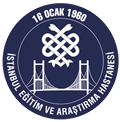ABSTRACT
Purpose:
The purpose of this study is to find out the prevalence ofvisual abnormalıties in preschoolchildren aged 1-6 years old and to revealout the importance ofvisıon screening in thıs age group.
Methods:
A total of 58 children ( 26 male,32 female) at daynursery of S.B. İstanbul Education and Re search Hospital were screened. Refraction, strabismus and anterior segment examinations were done to each ch i/d. For thıs screening, snellen projectian chart, auto-.refractometer, retinoscope. biomıcroscope and indirect ophthalmoscope were used. İn refraction examınation, between + 1.00 and -0.50 ıs defined as emetropia, + 1.00 and above is defmed as hipermetropia, -0.50 and above is defıned as myopia, +1- 0.50 and above is defined as astigmatism.
Results:
The prevalence ojvisual abnormalities found among the 58 screened children were as follows: having any visual abnormality; 28,3%, refractive errors; 10 children (17,2%) strabismus;3 children (5,17%), blepharitis; 5 children (8,6%), allergic conjonctivitis; 4 children (6,89%), viral conjonctivitis; 3 children (5,17%). 80% of chidren with refractive error and 66,6% of chıldren with strabismus were diagnosed by this screening.
Conclusion:
This cross-sectional study reveals the importance of early diagnose and treatment of vısual disorders that lead to amblyopia such as refractive errors and strabismus. To decrease the prevalence of amblyopia the visual screening programs should be performed especially to preschool children.



